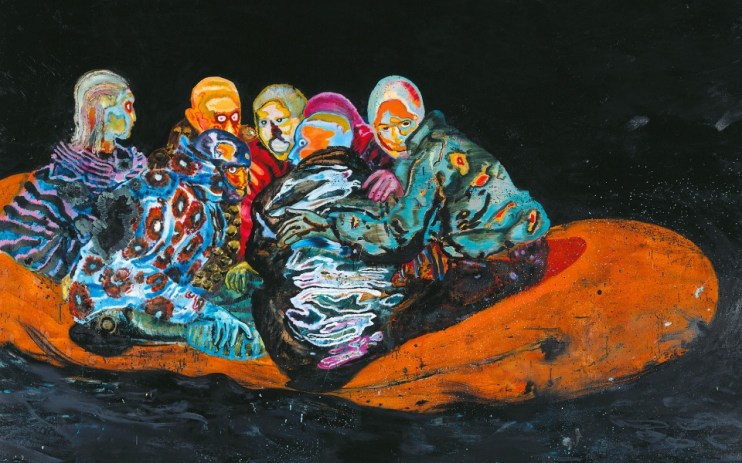Radical Figures at the Whitechapel Gallery review: Is painting really dead?

“This is an exhibition that testifies against the death of painting,” says Lydia Yee, curator of Radical Figures: Painting in the New Millennium at the Whitechapel Gallery. “Since painting was pronounced dead in the 1980s, a new generation of artists has been revitalising the expressive potential of figuration.”
So painting died in the 1980s? Yes – critics pronounced painting dead when neo-expressionism was born, says a plaque on the wall of the Whitechapel Gallery. But then so too did critic Gregory Battock in his 1969 essay Painting is Obsolete, art historian Kenneth Clark in his 1935 essay The Future of Painting, and French painter Paul Delaroche in 1840.
So when, precisely, did painting die? Though we might lay off a postmortem just yet, we can permit that painting has indeed been in existential crisis since the dawn of photography in the early 19th century. And there has been no age of photography quite like the proliferation we are currently living through. “Millions of photographs, selfies, live videos are taken every day,” says Yee. Radical Figures, featuring work by 10 artists from around the globe, claims to confront the relevance of the painted body in the age of the selfie. “How do you represent figures after the dominance of photography?”
A tough question, but this collection of artists do their best to paint a picture of the political and social anxieties that have plagued the bodies of our new millenium.
Tarifa by Daniel Richter is no doubt the standout of the show, tackling the riddle head-on with his depiction of migrants huddled on a lifeboat, rendered in a colourful palate that might initially pass as vibrancy, but that we soon realise is the cruel lens of an infrared camera.
Richter, with his allusions to the stranded bodies on the boats of Jericho and Delacroix, is not the only artist to collar the rich tradition of the body throughout art history.
Nicole Eisenman’s Brooklyn Beer Garden, painted in 2008, stubs out the joy of Renoir’s Moulin-goers with a huddle of down-and-out hipsters, drowning the sorrows of the financial crisis with booze and cigarettes. Her gigantic diptych on the opposite wall, Progress: Real and Imagined, riffs heavily off Bosch’s Garden of Earthly Delights. On one side is a playful, self-referential exploration of the inner life of an artist – collages, photographs, impasto blobs; a Peter Blake odyssey of identity. On the other, Eisenman grapples more directly with allegory; hunting, fishing, birth, death, cave drawings – figures inherited throughout history and rendered through the lens of contemporary sexual politics.
Michael Armitage’s reference to Velazquez’s Rokeby Venus in his painting #mydressmychoice, meanwhile, brings the image of the violated female body into the 21st century. Armitage lends his canvas to a woman who was filmed being sexually assaulted on public transport in Nairobi in 2014, with the video subsequently being posted online. If this exhibition seeks to offer the rubber stamp for painting’s place in a post-pixel world, Armitage’s work is its best bet. His brushstroke evokes a sympathy for the female sexual assault victim that goes beyond photography, or indeed video – he humiliates her attackers, and in doing so, humiliates the male gaze throughout art history. The painting is violent and challenging, its title echoing the waves of feminist movements that have punctuated the new millenium.
While most of the artists in this exhibition only go so far as bringing painting up to the current day thematically, Christina Quarles prods the boundaries of painting as a new textural medium. Quarles poses the question: what does queer identity look like? Her bodies are flesh-like but grey and genderless. Breasts here and there, a flop of blonde hair, but crude and distorted, struggling in their own skin. Quarles achieves this by bringing her background in graphic design onto the canvas. “I’ll stop halfway through, when I’ve painted a few figurative shapes, and I’ll put it on my computer and twist the bodies, add patterns, play with planes and vectors”. The result is a stage of awkward bodies being sucked into permed hedges – trapped in some liminal space that she says is “something like the nightmare of LA”.
Separately, then, these paintings have things to say. Radical Figures’ motley crew of artists confront well-trodden tropes in art history – the male gaze, outcasts, depression, queer identity – and bring them into our current landscape. At their best, they prove that painting is very much alive and kicking. But what is less sure is whether, as a collection, they say anything radical.
The exhibition’s dripping, distorted, and at times difficult bodies, are testament to the power of paint in depicting what cannot be captured by photography. But perhaps the most radical element of this exhibition is its claim that painting ever died. Though Radical Figures dunks its brush deep into the painterly tradition, it ultimately fails to do what it says on the paint tin.